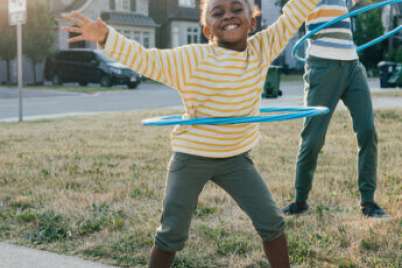
5 tips for allowing your child out of your sight outdoors
As hard as it may seem to let go, at some point in your child’s early years, you might want to allow them to work on a new milestone: venturing beyond your house and your yard, and then just out of sight for brief moments.
While there are risks with allowing your child to go just beyond the hearing and seeing distance of their supervising adult, there are also risks from denying them this experience. Your child, like all children, needs the occasional opportunity to explore without a hovering parent. Mastering a new level of responsibility will help your child build competence, confidence, and internal motivation, which will serve them as they grow older and get ready to take on new challenges and reach new milestones.
And although it’s hard to let go, holding on too tight is risky, too. Fortunately, there are ways to mitigate (not eliminate, but mitigate) the risks when your child heads off on an adventure that’s just out of sight of an adult. Here are five tips to keep your little one as safe as necessary:
Tip #1: There’s safety in numbers
Your child shouldn’t venture just beyond your seeing and hearing distance without a sibling or a buddy or two. Being part of a roving gang is protective to a small child, especially if it includes older children. Preschoolers in particular are naturally herd animals, you could say. If you’re not sure where your child is, but you see one of their buddies or a sibling whip around the corner, you can feel fairly confident that your own child is going to whip around that same corner in a moment, too.
Tip #2: Stay off the roads, to start
At first, let your child (and their buddies) wander out of sight at a park, where there are no cars. Or, let them rove from yard to yard. Or make it clear that if they’re playing on what we’re only colloquially referring to as “the street,” they need to stay on the sidewalks.
Tip #3: Practice, practice, practice traffic safety
As soon as your toddler begins walking, take every naturally arising opportunity to get them to “take the lead” in deciding whether it’s safe to cross. When you approach an intersection on foot, ask, “Do you see a car to your left? Do you see a car to your right? Do you think we can cross now?”
Of course, your one-year-old will have no clue what you mean, and your two-year-old won’t be too clear on what you’re trying to get at either, but by age three or age four, you’ll start to get glimmers of understanding. Especially if you help your child recognize and understand the cues they should be looking for. Those glimmers of understanding are built through practice.
Once your preschooler has demonstrated their competence in crossing a quiet, residential street with you, try letting them attempt the manoeuvre while you observe from a few feet back. From there, let them slowly work up their competence (and your confidence) by incrementally hanging back further as they cross the street.
Help your young child identify safer, quieter residential streets that have decent sight lines (i.e., fewer parked cars blocking the view). Again, this is a great opportunity to help your child recognize the information to look for: are there many cars? Are they speeding?
Learning traffic safety is like earning swimming lesson ribbons at the pool. Children need to earn the basic traffic-safety ribbons from Mom and Dad before they can safely advance to the more challenging levels.
Tip #4: Don’t allow them to be near water
Never leave a child unattended if there is a swimming pool or other body of water nearby.
Tip #5: Always be clear who the responsive adult(s) is
The magical moments in childhood happen when kids forget that adults even exist. But it’s easier for children to lose themselves in play if they have confidence that they can quickly find a helpful adult when they need one. Or if they know that their adult has a general sense of where they last were and how long they’ve been gone for. Children feel secure when they know that an adult is indirectly keeping track.
But they don’t necessarily need a responsible adult—one who diligently eliminates all risks (and adventure and serendipity). Instead, a responsive adult—one they can easily find and get help from when needed—will do the trick.
Other takeaways
If these five tips aren’t quite enough to convince you, there’s a good reason for that. And play researcher Dr. Peter Gray knows exactly what it is:
Peer pressure.
In surveys, many parents say that they would like to allow their children to play outdoors unsupervised and are aware that outdoor, unsupervised play is not recklessly dangerous, but they worried about how others would react if they saw children outside without an adult within visual distance. A wide-spread societal expectation is that parents are to provide children with 24/7 care.
But even just being aware that peer pressure is a thing—and a new thing at that—could give you the extra jolt of determination you need to take a deep breath and slowly, ever so slowly, let your child venture unsupervised on your street within visual distance, then on your street within shouting distance, and then beyond.
If you need help with examining your own comfort level, Outsideplay.ca is a Canadian-made online risk-assessment tool to help parents and caregivers.
Further reading:
Be a lifeguard to your child’s “risky” play
If in doubt, let them out: kids have a right to play
How to create a “risky play” backyard playground
Active for Life podcast: Dr. Mariana Brussoni on the value of risky play
What to do when you and your partner disagree about risky play






Excellent article! It’s scary letting your child out of your sight, but it’s a skill to be practised like all others